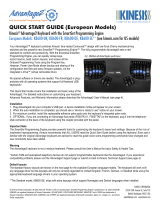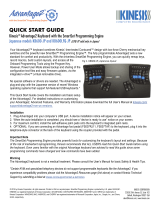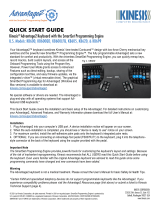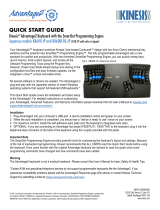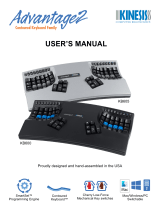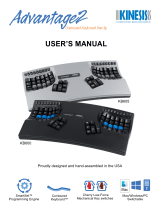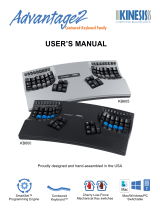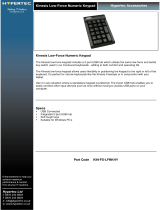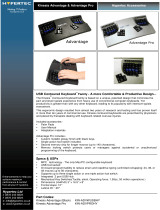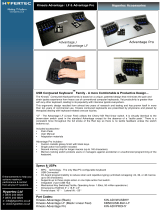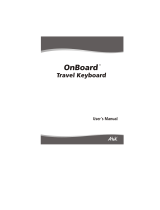Page is loading ...

Your Advantage2™ keyboard combines Kinesis’ time-tested Contoured™ design with low-force Cherry mechanical key
switches and the powerful new SmartSet™ Programming Engine™. The fully programmable Advantage2 sets a new
standard for comfort and productivity. With the driverless SmartSet
Programming Engine, you can quickly remap keys,
record macros, build custom layouts, and access all the
Onboard Programming Tools using the Program Key.
However, Power User Mode allows backup and sharing of the
configuration text files and easy firmware updates, via the
integrated v-drive™ (virtual removable drive).
No special software or drivers are needed. The Advantage2 is plug-
and-play with all operating systems that support full-featured USB
keyboards.*
This Quick Start Guide covers the installation and basic setup of the
Advantage2. For detailed instructions on customizing your keyboard, Advanced Features, and Warranty Information please downlo ad
the Advantage2 User’s Manual (see page 4).
Installation
1. Plug Advantage2 into your computer’s USB port. A device installation notice will appear on your screen.
2. When the auto-installation is completed, you should see a “device is ready to use” notice on your screen.
3. For maximum comfort, install the replaceable adhesive palm pads onto the keyboard’s integrated palm rests.
4. OPTIONAL: If you are connecting an Advantage foot pedal (FS007RJ11) to the keyboard, plug it into the telephone -style connector
at the back of the keyboard using the coupler provided with the pedal.
Important Note
The SmartSet Programming Engine provides powerful tools for customizing the keyboard’s layout and settings. Because of the ri sk of
inadvertent reprogramming, Kinesis recommends that ALL USERS read this Quick Start Guide before using the keyboard. Even user s
familiar with the original Advantage keyboard are advised to read this guide since some programming commands have changed and
new commands have been added. Also, any direct editing of configuration & layout files should be done with the US English key board
driver.
Warning
The Advantage2 keyboard is not a medical treatment. Please consult the User’s Manual for basic Safety & Health Tips.
*Certain KVM and specialized telephony devices do not support programmable keyboards like the Advantage2. If you experience
compatibility problems please visit the Advantage2 Support page or submit a ticket to Kinesis Technical Support (see page 4).
Default layouts
The standard factory layouts are shown on the next page for the available European language models. The keyboard will work wi th
any language driver but the keycaps will only be correctly legended for United Kingdom, French, German, or Swedish while usin g the
appropriate keyboard language drivers in your operating system.
QUICK START GUIDE (European Models)
© 2021 by Kinesis Corporation, all rights reserved. Printed in USA on recycled paper. SmartSet Programming Engine is protected by
U.S. patent 9,535,581. KINESIS is a registered trademark of Kinesis Corporation. ADVANTAGE2, CONTOURED KEYBOARD,
SMARTSET and V-DRIVE are trademarks of Kinesis Corporation. Other trademarks are property of their respective owners.

2
Fig 4. KB600-DE, German Layout (“DE” rmware version)
Fig 5. KB600-SE, Swedish Layout with Norwegian & Danish extra keycaps (“DE” rmware version”)
Fig 2. KB600-UK, United Kingdom Layout (“UK” rmware version)
Fig 3. KB600-FR, French Layout (“UK” rmware version)

3
Thumb Key Modes: PC, Windows, and Mac
Users may configure the four modifier keys in the thumb-operated clusters in one of three modes. All European models of the Advantage2
keyboard default to PC mode, which features the “Alt Gr” key used to generate the special key actions legended on the right s ide of certain
keycaps. Windows or Mac mode may be enabled using the onboard shortcuts (see below). Users who require both a Windows key and an
Alt Gr key can “remap” a Windows key action from the keypad layer of F1 or F2 to the key of their choice (see User’s Manual). An extra
Windows keycap and keycap removal tool are included for this purpose.
SmartSet Programming Engine
You may want to create custom layouts by moving (“remapping”) one or more key actions, or storing macros (pre -recorded key sequences)
triggered by a single alphanumeric key alone or in combination with a modifier key. There are also unique features and settin gs (e.g. Status
Report, macro speed, key clicks, toggle tones) that can be adjusted. The SmartSet Programming Engine provides Onboard Program ming to
customize your keyboard settings and layouts (see below).
If you plan to use the U.S. QWERTY keyboard driver instead of your native language keyboard driver, you can download the grap hical
SmartSet App for Advantage2 or try Direct Programming by manually editing the configuration and layout text files. However, t hese features
are intended for U.S. keyboards and the US QWERTY keyboard driver, so the legends of many keys on your keyboard will not matc h what
is shown in the App or in the text files.
SmartSet Onboard Programming Tools
To access the SmartSet Onboard Programming Tools (Fig 6), press and hold the Program Key (“progm”), then press the appropriate key in
the Function Key row, then release all keys. One or more LEDs will flash to indicate the programming command was successful.
Continuous LED flashing indicates that further actions are necessary to complete the programming command (e.g., for macros an d
remaps). To exit any active “Program Mode” simply tap the Program Key.
Note: Actions legended in lower case require only the Program Key to activate, whereas
actions legended in CAPS require the Program Key plus Shift Key to activate.
SmartSet Function Key Actions
•status (progm+esc): Prints detailed configuration Status Report to the screen.
Important note: The keyboard cursor must be in an active text editing screen before
running Status Report!
•qwert (progm+F3): Enables the QWERTY Layout, with any customizations.
•dvork (progm+F4): Enables the U.S. Dvorak Layout, which is not optimized for other
languages. Kinesis recommends this setting only if you are using English.
•mac (progm+F5): Enables Mac mode for thumb keys. Non-U.S. keyboards are not legended for
Mac mode so testing will be required to understand all key actions with non-U.S. languages and
keyboard drivers.
•pc (progm+F6): PC mode, the default thumb key mode for European models. It enables two Ctrl keys and two Alt keys, where the right Alt will
perform as “Alt Gr.” If you want a Win key, it can be remapped to your preferred location from the keypad layer (F1 or F2 with keypad on).
•win (progm+F7): Enables the default Windows Thumb Key Mode where the default RAlt key (AltGr) becomes RWin. If you use Win mode with a
European keyboard driver, you will not have access to AltGr. Another option is to use PC mode and remap a “Win” action (from the keypad layer of
F1 or F2) to your preferred location.
•click (progm+F8): Turns off/on the default Electronic Key Click feature. This is designed to help you avoid “bottoming out” the key.
•TONE (progm+Shift+F8): Turns off/on the Electronic Tone to alert users that keys for special “toggle” actions (Caps lock, Num lock, Scroll lock,
Insert, Keypad) have been hit. Two tones (double beep) indicates feature is “turned on” and one tone means “turned off.”
•RESET (progm+Shift+F9): Performs a Soft Reset which erases any key remapping, macros, and non-default thumb key mode setting for the
active layout. It does not reset macro speed, click, or tone settings. To perform a Hard Reset which erases all non-default settings in both
QWERTY and Dvorak layouts, hold progm+F9 until LEDs start flashing while plugging in keyboard.
•macro speed (progm+F10, then tap number row 1-9 or 0): Sets the global macro playback speed. Setting “0” Disables macro playback.
Playback speed can also be set separately for individual macros (see User’s Manual).
•progm macro (progm+F11): Enter Program Macro Mode. LEDs will flash fast prompting selection of trigger. Step 1: Select trigger key(s). One
alphanumeric key alone will suffice but can be combined with one or more modifier keys to serve as the macro trigger. Step 2: Type the desired
macro content (LEDs flash slowly while macro contents are being recorded). To save the macro, exit Program Macro Mode by tapping the Program
Key. Note: For detailed macro programming instructions including setting individual macro playback speed and delays, see User’s Manual.
Model> Advantage2
Firmware> 1.0.431.de (4MB), 11/14/2017
Acve layout le> qwerty.txt
Thumb keys mode> pc
Macro play speed> o=0, slow=1, normal=3, fast=9>
3
Status report play speed> o=0, slow=1, normal=3,
fast=4> 3
Keyclick status> on
Toggle tone status> on
Stored macros> 0
Keys remapped> 2
Fig 7. Status Report example (defaults shown for the
rmware used in German & Swedish keyboards)
Fig 6. Funcon Key Row (Cherry low-force ML mechanical key switches with tacle ridges)

4
•progm remap (progm+F12): Enter Program Remap Mode. Step 1: LEDs will flash fast prompting selection of the source key. Tap a key to
select the source key action. Step 2: LEDs flash slowly awaiting selection of the destination key—tap the destination key. Step 3: Program Remap
Mode remains active and will continue to accept key remapping “pairs” until exiting Remap mode by tapping the Program Key. Note: If you have
previously remapped your “source key,” in Program Remap Mode the keyboard reverts to the default action when selecting source action.
Print Screen, Scroll Lock & Pause Break
These keys perform standard keyboard functions which will depend on your Operating System and the application.
Multimedia Keys
The multimedia keys reside in the keypad layer and perform Mute, Volume Down, and Volume Up (see Fig 8).
Keypad Key & Keypad Layer
The Keypad Key toggles on a second virtual keyboard layer (the “keypad layer”) that can be used to remap keys and
store macros, or access the multimedia keys and the embedded numeric 10-key in the right keywell. Each QWERTY and
Dvorak Layout contains its own keypad layer that can be customized (see Fig 9). Keypad Layer actions are legended on
the front of the main keys and in blue on the function keys. PC Note: Num Lock must be on for 10-Key actions to register.
Remapping to or from the Keypad Layer
You may remap keys from Keypad Layer to the Top Layer and vice versa. Simply tap the Keypad Key before or during
the remap process to move between the two keyboard layers. For example, to remap from the Keypad Layer to the Top
Layer, press the Keypad Key to enter the Keypad Layer, enter Remap Mode, select the source action, press the Keypad
Key (keypad) to enter the Top Layer, and then select the destination key.
Optional foot pedal or remapping keypad “Toggle” or “Shift” action to access keypad layer
Frequent Keypad Layer users will benefit from an Advantage foot pedal (purchased separately) which can be used to temporarily “shift” the Keypad
Layer on by pressing and holding the pedal. Other keyboard keys may be assigned to perform either the keypad “shift” or “toggle” action, using the
SmartSet App when available, or via Direct Editing (see User’s Manual).
Palm pads and integrated palm rest
The palm rests are designed to provide comfortable support for your hands while not actively typing, though many users do rest their palms while
typing to relieve strain on the neck and shoulders. For maximum typing speed hold your palms slightly above the palm rests. Do not expect to
reach all of the keys while resting palms on the palm rests. For maximum comfort, install the self-adhesive palm
pads. Replacement pads are available for purchase.
LED Indicator Lights
The blue LEDs located near the center of the keyboard indicate the status of the keyboard. The LEDs will illuminate
when each of the four basic modes is active (see Fig 10). These LEDs also flash during SmartSet programming
actions (slow or fast) to indicate the keyboard’s temporary programming status.
Connecting an optional foot pedal
Plug the foot pedal into the telephone-style (RJ11) connector at the back of the keyboard. The single foot pedal acts as “keypad shift” — press to
access the keypad layer, release to return to top level. It can also be custom-programmed just like any key on the keyboard.
Power User Mode - Advanced features
For information on enabling Power User Mode to access Advanced Features, please consult the full User’s Manual.
Resources
To download the User’s Manual or the latest version of the Advantage2 firmware, please visit kinesis.com/support/advantage2-non-us-versions.
For further support, please submit a ticket at kinesis.com/support/contact-a-technician/.
/
